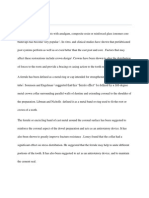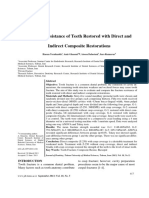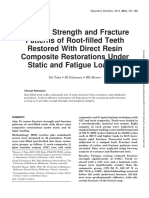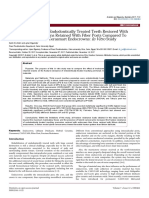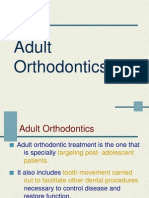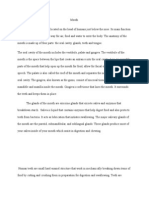jcdr-11-ZC49
jcdr-11-ZC49
Uploaded by
Thien LuCopyright:
Available Formats
jcdr-11-ZC49
jcdr-11-ZC49
Uploaded by
Thien LuCopyright
Available Formats
Share this document
Did you find this document useful?
Is this content inappropriate?
Copyright:
Available Formats
jcdr-11-ZC49
jcdr-11-ZC49
Uploaded by
Thien LuCopyright:
Available Formats
DOI: 10.7860/JCDR/2017/24669.
9675
Original Article
Effect of Different Ferrule Length on
Dentistry Section
Fracture Resistance of Endodontically
Treated Teeth: An In vitro Study
Sushil Kar1, Arvind Tripathi2, Chavi Trivedi3
ABSTRACT with prefabricated glass fibre posts (Reforpost, Angelus) and
Introduction: A ferrule has been described as a key element composite resin (Filtek™ Z250xt). Standardized preparation
of tooth preparation when using a post and a core. It is a was done on each specimen to receive a cast metal crown. The
vertical band of tooth structure at the gingival aspect of crown specimens were thermocycled and compressive static load at a
preparation. It lessens the stress transmission to the root which crosshead speed of 1 mm/min was applied at an angle of 30° on
is due to forces from posts or bending during seating of the post. lingual incline of buccal cusp of the crown until failure occurred.
The incorporation of a ferrule can help to withstand the forces The load (N) at failure and mode of failure were recorded.
of occlusion, preserve the hermetic seal of the luting cement, Statistical analysis was performed with Kruskal Wallis test.
and minimize the concentration of stresses at the junction of
post and core. Result: Fracture resistance values among the groups was found
to be statistically significant (p<0.001). The 3 mm ferrule group
Aim: To evaluate and compare the effect of ferrule length on
had significantly higher failure load (971.99+133.07) compared
fracture resistance of endodontically treated mandibular premolar
teeth, restored with prefabricated glass fiber post luted with resin to 2 mm (848.84+109.60), 1 mm (714.64+133.89) and 0 mm
cement, composite core and a full coverage metal crown. ferrule groups (529.36+119.95). More favourable failure modes
were observed in almost all groups.
Materials and Methods: Forty freshly extracted mandibular
premolars were treated endodontically. They were randomly Conclusion: The results of this study showed that fracture
divided into four groups according to their ferrule height: 3 mm, resistance of endodontically treated teeth increases as ferrule
2 mm, 1 mm and 0 mm (no ferrule). All specimens were restored length increases.
Keywords: Occlusal load, Polymerization, Thermocycle
INTRODUCTION Therefore, the aim of this study was to evaluate and compare the
Prosthetic rehabilitation of endodontically treated teeth has been effect of ferrule length on fracture resistance of endodontically
a challenge to dental practitioners. Following endodontic therapy, treated mandibular premolar teeth restored with prefabricated
substantial amount of tooth structure is lost due to caries, glass fiber post luted with resin cement, composite core and a full
trauma and endodontic procedures and it becomes a hollow coverage metal crown.
calcified laminated structure with deficient collagen cross linking
and reduced modulus of resiliency with increased fracture sus MATERIALS AND METHODS
ceptibility. Survival of such teeth is directly related to the quality as The present in vitro study was conducted in Department of
well as quantity of the remaining tooth structure [1]. Conservation Prosthodontics, Saraswati Dental College and Hospital, Lucknow,
of sound coronal dentin permits placement of margin on Uttar Pradesh, India in collaboration with Central Institute of Plastic
remaining tooth structure which influences the fracture resistance Engineering and Technology, Lucknow. Forty extracted, human
of crowned endodontically treated teeth [2]. Reinforcement of permanent mandibular premolars of approximately same dimensions
fiber posts in endodontically treated teeth with insufficient coronal were selected for the study which was measured using an electronic
tooth structure produces a stress field similar to that of natural
digital Vernier's calliper (Mitutoyo/Digimatic, Japan) to make sure
teeth because of same elastic modulus as that of dentine, thus
that they satisfy the following inclusion criterias: Mesio-Distal (M-D)
restoring the tooth to function [3].
dimensions: 5 mm±1, Bucco-Lingual (B-L) dimensions: 7 mm±1,
Incorporation of a ferrule when restoring an endodontically treated root length atleast 15 mm [Table/Fig-1a,b]. Additionally, periapical
tooth with a post-core and a crown always enhance the prognosis B-L and M-D radiographic views were taken to ensure the presence
of the tooth. A ferrule has been defined as a circumferential metal
of straight, single canal orifice, and completely formed apices. The
collar of the crown surrounding the parallel walls of the dentine
teeth were inspected to exclude any defects or cracks, restorations
extending coronal to the margin of the preparation [4]. The ferrule
or caries and previous endodontic restorations. Disinfection of the
improves biomechanical stability of the tooth by improving resistance
specimens was done using 0.5% chloramine T aqueous solution at
to dynamic occlusal loading and integrity of the cement seal of the
prosthesis. Studies have validated the use of atleast 1.5 mm ferrule 4°C for one week. Subsequently the selected teeth were stored in
as most effective in resisting fracture under load [5-7]. Many studies normal saline throughout the procedure to prevent desiccation.
investigating the ferrule effect have used cast post and core and A reference line was marked with graphite pencil at the Cemento-
generally on anterior teeth [8-12], but there is little information as to Enamel Junction (CEJ) of the experimental group specimens.
whether ferrule length has an added advantage along with fiber post The marking was based on digital vernier calliper measurements.
and composite core in premolar tooth. Sectioning the coronal tooth structure, at the reference lines, was
done perpendicular to the long axis of the teeth using a diamond
Journal of Clinical and Diagnostic Research. 2017 Apr, Vol-11(4): ZC49-ZC52 49
Sushil Kar et al., Effect of Different Ferrule Length on Fracture Resistance of Endodontically Treated Teeth www.jcdr.net
disc with low speed straight handpiece. The resultant coronal tooth Statistical analysis
surface was flat, rather than following the undulations of the CEJ The data was analysed using Statistical Package for Social
under constant water irrigation. To standardize the specimen’s Sciences, version 15.0, distributions were checked for normality
length, the crowns of the selected teeth were removed according to using Kolmogorov Smirnov test and failure mode was recorded
ferrule heights; Group A: no ferrule; Group B: 1 mm ferrule; Group and statistically analysed with Kruskal Wallis test.
C: 2 mm ferrule; Group D: 3 mm ferrule.
Standardized endodontic procedure was carried out on all
specimens using Protaper® (Dentsply Maillefer, Ballaigues), canals
were irrigated with 3% NaOCl and obturated with F2 ProTaper
guttapercha cones (Dentsply Maillefer, Ballaigues) using AH Plus
Sealer (Dentsply Maillefer, Switzerland). Finally to ensure full setting
of the seal, the teeth were stored in a 100% humid environment at
37°C for 24 hours.
Guttapercha removal was performed with Gates Glidden drills (3#)
taking care to preserve 4 mm apical seal. Radiographs were taken
to evaluate the adequacy of the remaining dentine structure around
the post space preparation. For standardized orientation of all
specimens into resin filled moulds, dental surveyor was used [Table/
Fig-1c]. Root surfaces were marked 3 mm below the CEJ. To simulate
the periodontal ligament, the root surfaces were covered with two
layers of 0.075 mm thick heat-resistant polytetrafluoroethylene
adhesive tape and coated with petroleum jelly. Silicone impression
material (Alphasil®, Germany) was mixed and injected around tooth
to produce a standardized silicone layer of 0.15 mm to simulate [Table/Fig-2]: a) Tooth was prepared using a high speed rotary handpiece mounted
in a dental surveyor; b) Specimen placed on UTM (Instron 3382) for loading.
periodontal ligament.
Prefabricated glass fiber post (Reforpost, Angelus) of 0.9 mm
diameter at their apical section and 1.3 mm diameter at their coronal
section were selected for the study [Table/Fig-1d]. The dual-cure
resin cement RelyXTM U200 was used for post cementation. The
specimens were left undisturbed for 15 minutes prior to storage
in 100% humidity environment at 37°C for 24 hours. Composite
resin (for core build up) was placed in increments with 40 seconds
of polymerization. Standardized preparation was done in each
specimen using a high speed rotary handpiece [Table/Fig-2a].
[Table/Fig-3]: a) Favourable fracture; b) Unfavourable fracture.
Crowns were luted with glass ionomer cement.
Distilled water was selected to store the specimens at a temperature
of 37°C with 100% humidity for 24 hours. Subsequently the
RESULTs
The mean value of fracture resistance, standard deviation and inter
specimens were thermocycled for 500 times from 5° to 55°C using
group comparison was recorded and statistically analysed using
30 second dwell times. The mounted specimens were aligned with
Kruskal Wallis test [Table/Fig-4]. The specimens (n=40) had a mean
the long axis of the tooth at 30° to the loading rod tip. This jig was
fracture resistance of (766.21+204.91 N) with values ranging from
secured to the lower compartment of a Universal Testing Machine
a minimum of 364.66 N to a maximum of 1253.67 N. Fracture
(UTM) (Instron 3382). A flat steel tip with compressive head was
resistance was found to be lowest for Group A (529.36±119.95 N)
used to apply the load on lingual incline of buccal cusp. It was fixed
followed by Group B (714.64±133.89 N), Group C (848.84±109.60 N)
to the moving upper compartment of the testing machine [Table/
and highest for Group D (971.99±133.07 N) [Table/Fig-4]. Difference
Fig-2b]. The compressive load was applied at a crosshead speed
in fracture resistance values among the groups was found to be
of 1 mm/min until failure occurred. The failure mode was evaluated
statistically significant (p<0.001).
by visual examination of the specimens to classify its type [13].
Then a stereomicroscope (Olympus, U-CMAD3, Japan) was used Though fracture was found to be favourable in higher proportion
for further evaluation of the mode of failure. The failure mode of Group D (90.0%) as compared to Group B (80.0%), Group C
was classified as either favourable (restorable) or unfavourable (80.0%) and Group A (70.0%) [Table/Fig-5], they were not statistically
(catastrophic) [Table/Fig-3a,b]. Favourable failure modes are those significant.
that take place above the level of acrylic resin which simulate the
bone level. They include either partial or complete post-core- DISCUSSION
crown debonding or post-core-tooth complex fracture above Advancements in the field of restorative dentistry have markedly
acrylic resin block. Unfavourable failure occurs below the level of increased the probabilities of successful restoration of severely
the acrylic resin. It includes fracture of the post-core-root complex, damaged endodontically treated teeth. The preservation of tooth
cracks in the roots or vertical root fractures. structure in endodontically treated tooth improves its prognosis
because it provides protection against fracture under occlusal
loads. A ferrule, in respect to the teeth, is a band that encircles the
external dimension of residual tooth structure.
In the present study, influence of ferrule length on fracture resistance
and failure pattern of endodontically treated crowned mandibular
premolars reinforced with composite core and fiber post was
[Table/Fig-1]: a) Dimension of crown measured using an electronic digital Vernier's
caliper; b) Dimension of root measured using an electronic digital Vernier's caliper;
investigated. The decision to place a post in endodontically treated
c) Specimens mounted into resin filled moulds; d) Length of the post (standardized) tooth depends upon amount of loss of tooth structure and also the
using an electronic digital Vernier's caliper. amount of functional forces on tooth [14,15]. Many investigators
50 Journal of Clinical and Diagnostic Research. 2017 Apr, Vol-11(4): ZC49-ZC52
www.jcdr.net Sushil Kar et al., Effect of Different Ferrule Length on Fracture Resistance of Endodontically Treated Teeth
No. of Minimum Maximum Mean Statistical significance
Group S.D. Median Mean Rank
specimens (Newton) (Newton) (Newton) H p
Group A 10 364.66 698.40 529.36 119.95 522.16 7.20
Group B 10 594.77 984.67 714.64 133.89 658.23 16.80
25.665 <0.001
Group C 10 693.00 1018.14 848.84 109.60 810.01 26.20
Group D 10 854.74 1253.67 971.99 133.07 925.39 31.80
Total 40 364.66 1253.67 766.21 204.91 767.58
[Table/Fig-4]: Inter groups comparison of compressive load (Kruskal Wallis test: Non-Parametric ANOVA).
proportion of Group D (90.0%) as compared to Group B, Group
Group A Group B Group C Group D
(n = 10) (n = 10) (n = 10) (n = 10) C (80.0% each) and Group A (70.0%) but this difference was not
found to be significant.
No. % No. % No. % No. %
Favourable 7 70.0 8 80.0 8 80.0 9 90.0
Although the design of the current study attempted to simulate
clinical situations such as ferrule preparation, periodontal ligament
Unfavourable 3 30.0 2 20.0 2 20.0 1 10.0
and cast crown, it is difficult to implement these results directly for
[Figure/Fig-5]: Favourability of fracture among the groups. the clinical practice because it is an in vitro study which could not
fully replicate oral conditions. Besides the type of test used, that is,
have reported that post placement affects fracture resistance and a static load which does not represent the oral condition. The study
increases the potential risk of root fracture and root fracture was also evaluated the mandibular premolar and therefore, the results
reported with the use of metallic posts [16,17]. Fiber posts were can be applied only to that group of teeth.
investigated to have modulus of elasticity which was similar to that
of dentine, and thus producing a stress field similar to that of natural CONCLUSION
teeth. It was thought that fiber posts lowered the interfacial stress Under the limitation of this study, the following conclusions were
and reduced the chances of failure [18]. Since the physiological drawn: Increasing the ferrule length can significantly increase
properties of a periodontal ligament in teeth under load potentially the fracture resistance of the endodontically treated mandibular
affects the results, periodontal ligament simulation was done premolars restored with a glass fibre post luted with RelyX™ U200
to be as close as possible to the clinical situation. To mimic the self adhesive resin cement, composite core and metal crown. All the
clinical oral conditions mandibular premolars were stored in normal intergroup differences, except between Group C and Group D were
saline at 37°C and they were loaded at an angle in UTM which statistically significant. The following order of fracture resistance
corresponded to the loading angulation of mandibular premolar in was observed among the different groups: Group A< Group B <
natural dentition. Group C < Group D. Almost all the subgroups had favourable type
In the present study, the fracture resistance of teeth was tested under of failures.
static load to stimulate forceful clenching. The results confirmed
that the endodontically treated teeth with the presence of a ferrule REFERENCES
had superior fracture resistance under a static load than those that [1] Assif D, Gorfil C. Biomechanical considerations in restoring endodontically
lacked ferrule and increasing the ferrule length significantly increased treated teeth. J Prosthet Dent. 1994;71:565-67.
[2] Lima A F, Spazzin AO, Galafassi D, Correr-Sobrinho L, Carlini-Júnior B. Influence
the fracture resistance of endodontically treated teeth restored of ferrule reparation with or without glass fiber post on fracture resistance of
with glass fiber posts, composite cores and crowns (p<0.001). In endodontically treated teeth. J Appl Oral Sci. 2010;18(4):360-63.
another study, Sorensen JA and Martinoff JT showed that 1 mm [3] Ferrari M, Cagidiaco MC, Grandini S, De Sanctis, M, Goracci C. Post placement
affects survival of endodontically treated premolars. J Dent Res. 2007;86:729-
of remaining coronal tooth structure nearly doubled the fracture
34.
resistance of the endodontically treated teeth [19]. [4] Sorensen JA, Engelman MJ. Ferrule design and fracture resistance of
The results of the present study are in agreement with other studies endodontically treated teeth. J Prosthet Dent. 1990;63:529-36.
[5] Stankiewicz NR, Wilson PR. The ferrule effect: A literature review. Int Endod J.
[20,21]. The lowest mean failure load recorded from the subgroup 2002;35:575-81.
having no ferrule was 529.36 N. [6] Ferrario VF, Sforza C, Serrao G, Dellavia C, Tartaglia GM. Single tooth bite forces
in healthy young adults. J Oral Rehabil. 2004;31:18-22.
Additionally, the results indicated that the 3 mm ferrule length group
[7] Libman WJ, Nicholls JI. Load fatigue of teeth restored with cast posts and cores
presented significantly highest mean failure load (971.99 N) when and complete crowns. Int J Prosthodont.1995;8:155–61.
compared with the 2 mm (848.84 N), 1 mm ferrule (714.64 N) and [8] Dikbas I, Tanalp J, Ozel E, Koksal T, Ersoy M. Evaluation of the effect of
0 mm (529.36 N) ferrule group. These variations of failure load different ferrule designs on the fracture resistance of endodontically treated
maxillary central incisors incorporating fibre posts, composite cores and crown
between different ferrule height groups may be attributed to several
restorations. J Contemp Dent Pract. 2007;8:62-69.
mechanisms of action as explained by Tan PL et al., [22]. The most [9] Signore A, Benedicenti S, Kaitsas V, Barone M, Angiero F, Ravera G. Long-term
reasonable explanation was that the amount of remaining coronal survival of endodontically treated, maxillary anterior teeth restored with both
dentin provided a more stable foundation which helps to redistribute tapered or parallel-sided glass-fiber posts and full-ceramic crown coverage. J
Dent. 2009;37:115-21.
and dissipate the applied forces. Subsequently, greater resistance
[10] Pereira JR, de Ornelas F, Conti PC, Valle AL. Effect of a crown ferrule on the
to rotation was achieved and fracture resistance of endodontically fracture resistance of endodontically treated teeth restored with prefabricated
treated tooth increased. Our results disagree with the study done by posts. J Prosthet Den. 2006;95:50-54.
Al-Hazaimeh and Gutteridge DL [23]. They used prefabricated metal [11] Zhi-Yue L, Yu-Xing Z. Effects of post-core design and ferrule on fracture
resistance of endodontically treated maxillary central incisors. J Prosthet Dent.
post (parapost) which were cemented with Panavia-ex and restored
2003;89:368-73.
with a composite core and studied the effect of 2 mm of ferrule [12] Akkayan B. An in vitro study evaluating the effect of ferrule length on fracture
preparation on the fracture resistance of crowned central incisors. resistance of endodontically treated teeth restored with fibre-reinforced and
They concluded that the additional increase in ferrule heights has zirconia dowel systems. J Prosthet Dent. 2004;9:155-62.
[13] Fokkinga WA, Kreulen CM, Vallittu PK, Creugers NH. A structured analysis of in
no benefit in terms of resistance to fracture. One explanation might vitro failure loads and failure modes of fibre, metal and ceramic post and core
be due to the fact that they evaluated the effect of different ferrule systes. Int J Prosthodont. 2004;17(4):476-82.
designs and configurations but at the same length. While in this [14] Mangold JT, Kern M. Influence of glass fiber post on fracture resistance and
study, effects of different ferrule lengths in the same design were failure pattern of endodontically treated premolar with varying substance loss: An
in vitro study. J Prosthet Dent. 2011;105(6):387-93.
evaluated. Though the fracture was found to be favourable in higher
Journal of Clinical and Diagnostic Research. 2017 Apr, Vol-11(4): ZC49-ZC52 51
Sushil Kar et al., Effect of Different Ferrule Length on Fracture Resistance of Endodontically Treated Teeth www.jcdr.net
[15] Al-Omiri MK, Mahmoud AA, Rayyan MR, Abu-Hammad O. Fracture resistance [20] Isidor F, Brondum K, Ravnholt G. The influence of post length and crown ferrule
of teeth restored with post-retained restorations: An overview. J Endod. length on the resistance to cyclic loading of bovine teeth with prefabricated
2010;36:1439-49. titanim posts. Int J Prosthodont. 1999;12:78-82.
[16] Sendhilnathan D, Nayar S. The effect of post-core and ferrule on the fracture [21] Varvara G, Perinetti G, Di Iorio, Murmura G, Caputi S. In vitro evaluation of
resistance of endodontically treated maxillary central incisors. Indian J Dent Res. fracture resistance and failure mode of internally restored endodontically
2008;19:17-21. treated maxillary incisors with different heights of residual dentine. J Prosthet
[17] Martinez-Insua A, da Silva L, Rilo B, Santanu U. Comparison of the fracture Dent. 2007;98:365-72.
resistances of pulpless teeth restored with a cast post and core or carbon [22] Tan PL, Aquilino SA, Gratton DG. In vitro fracture resistance of endodontically
treated central incisors with varying ferrule heights and configurations. J Prosthet
fibrepost with a composite core. J Prosthet Dent. 1998;80:527-32.
Dent. 2005;93:331-36.
[18] Aggarwal V, Singla M, Miglani S, Kohli S. Comparative evaluation of fracture
[23] Al-Hazaimeh N, Gutteridge DL. An in vitro study into the effect of the ferrule
resistance of structurally compromised canals restored with different dowel
preparation on the fracture resistance of crowned teeth incorporating
methods. J Prosthodont. 2012;21:312-16.
prefabricated post and composite core restorations. Int Endod J. 2001;34:
[19] Sorensen JA, Martinoff JT. Clinically significant factors in dowel design. J Prosthet
40-46.
Dent. 1984;52:28-35.
PARTICULARS OF CONTRIBUTORS:
1. Professor, Department of Prosthodontics, Saraswati Dental College, Lucknow, Uttar Pradesh, India.
2. Professor and Head, Department of Prosthodontics, Saraswati Dental College, Lucknow, Uttar Pradesh, India.
3. Junior Resident, Department of Prosthodontics, Saraswati Dental College, Lucknow, Uttar Pradesh, India.
NAME, ADDRESS, E-MAIL ID OF THE CORRESPONDING AUTHOR:
Dr. Sushil Kar,
Professor, Department of Prosthodontics, Saraswati Dental College,
Date of Submission: Oct 07, 2016
Tiwari Ganj, Faizabad Road, Lucknow-227105, Uttar Pradesh, India.
E-mail: drsushil_kar@yahoo.co.in Date of Peer Review: Dec 10, 2016
Date of Acceptance: Feb 01, 2017
Financial OR OTHER COMPETING INTERESTS: None. Date of Publishing: Apr 01, 2017
52 Journal of Clinical and Diagnostic Research. 2017 Apr, Vol-11(4): ZC49-ZC52
You might also like
- CastelnuovoDocument10 pagesCastelnuovoabdulaziz alzaidNo ratings yet
- Pit and Fissure SealantsDocument34 pagesPit and Fissure SealantsSamridhi SrivastavaNo ratings yet
- Endo Don TicsDocument11 pagesEndo Don TicsLang100% (1)
- JOURNALDocument5 pagesJOURNALrenukasakthi93No ratings yet
- 76 Ijdm OaDocument6 pages76 Ijdm Oaamulya.kukutlaNo ratings yet
- Tangsripongkul2020 PDFDocument5 pagesTangsripongkul2020 PDFdrpriyanka patelNo ratings yet
- TECHNIQUE TO MAKEالصفيحة المعدنية للطقم الكاملDocument7 pagesTECHNIQUE TO MAKEالصفيحة المعدنية للطقم الكاملAbood AliNo ratings yet
- Borzangy, 2019Document8 pagesBorzangy, 2019phaelzanonNo ratings yet
- Effect of Ferrule Thickness On Fracture Resistance of Teeth Restored With A Glass Fiber Post or Cast PostDocument10 pagesEffect of Ferrule Thickness On Fracture Resistance of Teeth Restored With A Glass Fiber Post or Cast PostStephanie PinedaNo ratings yet
- Ferrule EffectDocument11 pagesFerrule EffectJaysondeAsisNo ratings yet
- 1 s2.0 S0099239909006116 MainDocument5 pages1 s2.0 S0099239909006116 MainDANTE DELEGUERYNo ratings yet
- Technique For Fabrication of Customised Metal Mesh Reinforced Complete Dentures - Pressing Need To Avoid Complete Denture Fractures A Case ReportDocument4 pagesTechnique For Fabrication of Customised Metal Mesh Reinforced Complete Dentures - Pressing Need To Avoid Complete Denture Fractures A Case ReportInternational Journal of Innovative Science and Research TechnologyNo ratings yet
- 1 s2.0 S002239132300687X MainDocument8 pages1 s2.0 S002239132300687X MainLeandroMartinsNo ratings yet
- Fracture Resistance of Endodontically Treated TeethDocument6 pagesFracture Resistance of Endodontically Treated TeethdrrayyanNo ratings yet
- Evaluation of Fracture Resistance of Endodontically Treated Teeth Restored With Composite Resin Along With Fibre Insertion in Different Positions in VitroDocument6 pagesEvaluation of Fracture Resistance of Endodontically Treated Teeth Restored With Composite Resin Along With Fibre Insertion in Different Positions in VitroDanish NasirNo ratings yet
- Franco 2014Document5 pagesFranco 2014Juan Francisco CamposNo ratings yet
- Adhesive Restoration of Anterior Endodontically Treated TeethDocument10 pagesAdhesive Restoration of Anterior Endodontically Treated TeethEugenioNo ratings yet
- Are Endodontically Treated Teeth More BrittleDocument4 pagesAre Endodontically Treated Teeth More BrittleArturo Trejo VeraNo ratings yet
- Stress - Distribution - and - Fracture - Resistance of Treat Crack PropagationDocument7 pagesStress - Distribution - and - Fracture - Resistance of Treat Crack PropagationabdelazizNo ratings yet
- Fracture Resistance of Endodontically Treated Maxillary PremolarDocument8 pagesFracture Resistance of Endodontically Treated Maxillary Premolarjdac.71241No ratings yet
- Coronal Tooth Structure in Root-Treated Teeth Prepared For Complete and Partial Coverage RestorationsDocument11 pagesCoronal Tooth Structure in Root-Treated Teeth Prepared For Complete and Partial Coverage RestorationsSMART SMARNo ratings yet
- Fracture Resistance of Anterior Endocrown Vs Post Crown Invitro Study Restoration AnDocument10 pagesFracture Resistance of Anterior Endocrown Vs Post Crown Invitro Study Restoration AnMASSIEL GISETH MARTINEZ OLIVELLANo ratings yet
- A Finite Element Analysis of Ferrule Design PDFDocument10 pagesA Finite Element Analysis of Ferrule Design PDFRamona MateiNo ratings yet
- Tensile Stress Distribution in Maxillary Central Incisors Subjected To Various Dental Post and Core ApplicationsDocument8 pagesTensile Stress Distribution in Maxillary Central Incisors Subjected To Various Dental Post and Core ApplicationsAhmed MadfaNo ratings yet
- Reduction Resto ProcedureDocument5 pagesReduction Resto ProcedureAnindyaNoviaPutriNo ratings yet
- WearDocument6 pagesWeardra.claudiamaria.tiNo ratings yet
- Fracture load and mode of failure of ceramic veneersDocument10 pagesFracture load and mode of failure of ceramic veneersCristina AdrianNo ratings yet
- Zircon Abut Reference PDFDocument4 pagesZircon Abut Reference PDFVidya SenthuNo ratings yet
- Ya IniDocument7 pagesYa IniAnditaNo ratings yet
- Comparison of Different Post Systems For Fracture Resistance: An in Vitro StudyDocument4 pagesComparison of Different Post Systems For Fracture Resistance: An in Vitro StudyStephanie PinedaNo ratings yet
- Contracted Endodontic AccessDocument48 pagesContracted Endodontic AccessSanket Pandey93% (27)
- Fracture Resistance and Microleakage of Endocrowns Utilizing Three CAD-CAM BlocksDocument10 pagesFracture Resistance and Microleakage of Endocrowns Utilizing Three CAD-CAM BlocksZen AhmadNo ratings yet
- 2013 The Influence of Ferrule Effect and Length of Cast and FRC Posts On The Stresses in Anterior Teeth - DejakDocument11 pages2013 The Influence of Ferrule Effect and Length of Cast and FRC Posts On The Stresses in Anterior Teeth - DejaktovarichNo ratings yet
- 3D-Finite Element Analysis of Molars Restored WithDocument9 pages3D-Finite Element Analysis of Molars Restored Withabhilashanand3No ratings yet
- Stress Distribution in Molars Restored With Inlays or Onlays With or Without Endodontic Treatment: A Three-Dimensional Finite Element AnalysisDocument7 pagesStress Distribution in Molars Restored With Inlays or Onlays With or Without Endodontic Treatment: A Three-Dimensional Finite Element AnalysismusaabsiddiquiNo ratings yet
- Chan Et Al-2018-Australian Dental JournalDocument10 pagesChan Et Al-2018-Australian Dental JournaldentistsalimNo ratings yet
- Influence of Preparation Design and Ceramic Thicknesses On Fracture Resistance and Failure Modes of Premolar Partial Coverage RestorationsDocument19 pagesInfluence of Preparation Design and Ceramic Thicknesses On Fracture Resistance and Failure Modes of Premolar Partial Coverage Restorationsemanuelle.guidugliNo ratings yet
- Telescopic Overdenture: A Case Report: C. S. Shruthi, R. Poojya, Swati Ram, AnupamaDocument5 pagesTelescopic Overdenture: A Case Report: C. S. Shruthi, R. Poojya, Swati Ram, AnupamaRani PutriNo ratings yet
- Metal Ceramic Dowel Crown RestorationsDocument4 pagesMetal Ceramic Dowel Crown RestorationsCezara ZahariaNo ratings yet
- Resistencia La Fractura de Incrustaciones de ResinaDocument9 pagesResistencia La Fractura de Incrustaciones de ResinaPatrick Castillo SalazarNo ratings yet
- Comparison of Fracture Strength of Endocrowns and Glass Fiber Post - Retained Conventional CrownsDocument7 pagesComparison of Fracture Strength of Endocrowns and Glass Fiber Post - Retained Conventional CrownsDiego ZambranoNo ratings yet
- Comparative Evaluation of Pericervical Dentin Preservation and Fracture Resistance of Root Canal Treated Teeth With Rotary Endodontic File Systems of Different Types of TaperDocument5 pagesComparative Evaluation of Pericervical Dentin Preservation and Fracture Resistance of Root Canal Treated Teeth With Rotary Endodontic File Systems of Different Types of TaperMegha GhoshNo ratings yet
- Microscopy Res Technique - 2022 - Fildisi - The Effect of Fiber Insertion On Fracture Strength and Fracture Modes inDocument9 pagesMicroscopy Res Technique - 2022 - Fildisi - The Effect of Fiber Insertion On Fracture Strength and Fracture Modes infthgyzyvh9No ratings yet
- 10 1016@j Joen 2013 07 034Document4 pages10 1016@j Joen 2013 07 034Asmita SonawneNo ratings yet
- Is Fracture Resistance of Endodontically Treated Mandibular Molars Restored With Indirect Onlay Composite Restorations Influenced by Fibre Post Insertion?Document7 pagesIs Fracture Resistance of Endodontically Treated Mandibular Molars Restored With Indirect Onlay Composite Restorations Influenced by Fibre Post Insertion?Millie Vega100% (1)
- Fracture Strength and Fracture Patterns of Root-Filled Teeth Restored With Direct Resin Composite Restorations Under Static and Fatigue LoadingDocument8 pagesFracture Strength and Fracture Patterns of Root-Filled Teeth Restored With Direct Resin Composite Restorations Under Static and Fatigue LoadingLala LalaNo ratings yet
- Maroulakos 2015Document8 pagesMaroulakos 2015EugenioNo ratings yet
- Assessment of Fracture Resistance of Endocrown Constructed of Two Different Materials Compared To Conventional Post and Core Retained CrownDocument20 pagesAssessment of Fracture Resistance of Endocrown Constructed of Two Different Materials Compared To Conventional Post and Core Retained CrownDr-Ahmed Yahya ElRefaayNo ratings yet
- Impacts of Contracted Endodontic Cavities On Instrumentation Efficacy and Biomechanical Responses in Maxillary MolarsDocument5 pagesImpacts of Contracted Endodontic Cavities On Instrumentation Efficacy and Biomechanical Responses in Maxillary MolarsDaniel VivasNo ratings yet
- Dentin Post - A New Method For Reinforcing The ToothDocument7 pagesDentin Post - A New Method For Reinforcing The ToothGauri AroraNo ratings yet
- Endocrown Biacchi Basting 2012Document7 pagesEndocrown Biacchi Basting 2012Andre PereiraNo ratings yet
- 1Document9 pages1Lakshmi PriyaNo ratings yet
- 2 PDFDocument4 pages2 PDFPutri AmaliaNo ratings yet
- Efficacy of Ribbond and A Fibre Post On The Fracture Resistance of Reattached Maxillary Central Incisors With Two Fracture PatternsDocument6 pagesEfficacy of Ribbond and A Fibre Post On The Fracture Resistance of Reattached Maxillary Central Incisors With Two Fracture PatternsPao JanacetNo ratings yet
- Effect of Length Post and Remaining Root Tissue On Fracture Resistance of Fibre Posts Relined With Resin CompositeDocument8 pagesEffect of Length Post and Remaining Root Tissue On Fracture Resistance of Fibre Posts Relined With Resin Compositejhon HanselNo ratings yet
- 6.clinical Case ReportMultidisciplinary Approach For Rehabilitation of Debilitated Anterior ToothDocument6 pages6.clinical Case ReportMultidisciplinary Approach For Rehabilitation of Debilitated Anterior ToothSahana RangarajanNo ratings yet
- The Effect of Fiber Insertion On Fracture Resistance of Endodontically Treated Molars With MOD Cavity and Reattached Fractured Lingual CuspsDocument7 pagesThe Effect of Fiber Insertion On Fracture Resistance of Endodontically Treated Molars With MOD Cavity and Reattached Fractured Lingual CuspsRanulfo Castillo PeñaNo ratings yet
- Resistance To Fracture of Lower Premolars With Abrasion and Abfraction LesionsDocument5 pagesResistance To Fracture of Lower Premolars With Abrasion and Abfraction LesionsInternational Journal of Innovative Science and Research TechnologyNo ratings yet
- Influencia Del Diente Intraradicular y Lacorona Ferula Con La Resistencia Ala FracturaDocument6 pagesInfluencia Del Diente Intraradicular y Lacorona Ferula Con La Resistencia Ala FracturacatalinaNo ratings yet
- 2016 Salvation of Severely Fractured Anterior Tooth An Orthodontic ApproachDocument4 pages2016 Salvation of Severely Fractured Anterior Tooth An Orthodontic ApproachRajesh GyawaliNo ratings yet
- Esthetic Oral Rehabilitation with Veneers: A Guide to Treatment Preparation and Clinical ConceptsFrom EverandEsthetic Oral Rehabilitation with Veneers: A Guide to Treatment Preparation and Clinical ConceptsRichard D. TrushkowskyNo ratings yet
- mpr.2002.123227Document7 pagesmpr.2002.123227Thien LuNo ratings yet
- 2019-NÔNG ĐỘ-HINDAWIDocument6 pages2019-NÔNG ĐỘ-HINDAWIThien LuNo ratings yet
- 2023-1Document12 pages2023-1Thien LuNo ratings yet
- 2023Document36 pages2023Thien LuNo ratings yet
- NEW 2020-RANKL BIOLOGYDocument16 pagesNEW 2020-RANKL BIOLOGYThien LuNo ratings yet
- joor.13060Document31 pagesjoor.13060Thien LuNo ratings yet
- 2021-THEO DÕIDocument9 pages2021-THEO DÕIThien LuNo ratings yet
- j.1365-2842.2006.01682.xDocument5 pagesj.1365-2842.2006.01682.xThien LuNo ratings yet
- 2021-cementDocument13 pages2021-cementThien LuNo ratings yet
- 2019-An ĐokDocument11 pages2019-An ĐokThien LuNo ratings yet
- When To Choose Which Retention Element To Use For Removable Dental ProsthesesDocument8 pagesWhen To Choose Which Retention Element To Use For Removable Dental ProsthesesThien LuNo ratings yet
- Mong ĐoiDocument5 pagesMong ĐoiThien LuNo ratings yet
- Luc Can Nhatj BanDocument9 pagesLuc Can Nhatj BanThien LuNo ratings yet
- Success of Complete Denture Treatment Detailed InvDocument8 pagesSuccess of Complete Denture Treatment Detailed InvThien LuNo ratings yet
- Pulp Therapy - Tables BeatriceDocument7 pagesPulp Therapy - Tables BeatriceMikeNo ratings yet
- Buklet Krok 2 Stomatology 2015EDocument24 pagesBuklet Krok 2 Stomatology 2015Esheikhuzi83No ratings yet
- Patent Application Publication (10) Pub. No.: US 2011/0308030 A1Document19 pagesPatent Application Publication (10) Pub. No.: US 2011/0308030 A1Surajit SahaNo ratings yet
- Adult OrthodonticsDocument135 pagesAdult OrthodonticsSumit Jaggi100% (3)
- B.A.,D.D.S.,M.S.D. : Herbert Werdlow, Bethesda, MDDocument7 pagesB.A.,D.D.S.,M.S.D. : Herbert Werdlow, Bethesda, MDMuchlis Fauzi ENo ratings yet
- Facebow Tech Spec Gen LRDocument1 pageFacebow Tech Spec Gen LRrojNo ratings yet
- IPR - Class II MO Preparation Restoration of 36Document14 pagesIPR - Class II MO Preparation Restoration of 36kiranvarma2u50% (2)
- Use of Intraoral Scanning and 3-Dimensional Printing in The Fabrication of A Removable Partial Denture For A Patient With Limited Mouth OpeningDocument4 pagesUse of Intraoral Scanning and 3-Dimensional Printing in The Fabrication of A Removable Partial Denture For A Patient With Limited Mouth OpeningcinthiaNo ratings yet
- Tooth Erosion, Attrition, Abrasion & AbfractionDocument8 pagesTooth Erosion, Attrition, Abrasion & AbfractionCharlie McdonnellNo ratings yet
- Dental TerminologyDocument3 pagesDental TerminologyJosue MHNo ratings yet
- Armamentarium For Local Anesthesia and Extraction of Teeth: Najeeb Ullah Final Year BDSDocument44 pagesArmamentarium For Local Anesthesia and Extraction of Teeth: Najeeb Ullah Final Year BDSatikaNo ratings yet
- Comparison of 2 Treatment ProtocolsDocument7 pagesComparison of 2 Treatment ProtocolsSaherish FarhanNo ratings yet
- Anatomy and Physiology MouthDocument4 pagesAnatomy and Physiology MouthAndrew BimbusNo ratings yet
- Nayak 2017Document9 pagesNayak 2017papasNo ratings yet
- J of Oral Rehabilitation - 2021 - Zonnenberg - Centric Relation Critically Revisited What Are The Clinical ImplicationsDocument6 pagesJ of Oral Rehabilitation - 2021 - Zonnenberg - Centric Relation Critically Revisited What Are The Clinical ImplicationsVasu SinghNo ratings yet
- Nightguard Vital Bleaching of Tetracycline - Stained Teeth: 90 Months Post TreatmentDocument12 pagesNightguard Vital Bleaching of Tetracycline - Stained Teeth: 90 Months Post TreatmentMarcosLopesNo ratings yet
- DP OussamaDocument4 pagesDP OussamaDinda Tryana SembiringNo ratings yet
- Biology of The Dental Pulp and Periradicular TissuesDocument34 pagesBiology of The Dental Pulp and Periradicular TissuesFatima SiddiquiNo ratings yet
- TiptonDocument5 pagesTiptoncsbNo ratings yet
- Smith CTDocument7 pagesSmith CTvishalbalpandeNo ratings yet
- Management of Dentinehypersensitivity Ef Cacy Ofprofessionally Andself-Administered AgentsDocument47 pagesManagement of Dentinehypersensitivity Ef Cacy Ofprofessionally Andself-Administered AgentsNaoki MezarinaNo ratings yet
- SprintRay Workflow Guide CrownDocument15 pagesSprintRay Workflow Guide CrownBhaskar GuptaNo ratings yet
- 5488-Dental ModifyDocument8 pages5488-Dental ModifyRashmita NayakNo ratings yet
- ITI Decision Trees and ChecklistsDocument6 pagesITI Decision Trees and ChecklistsNay Aung100% (1)
- RPD Impression ModifiedDocument27 pagesRPD Impression ModifiedPrince AhmedNo ratings yet
- Jdo Vol 70Document74 pagesJdo Vol 70Jair OliveiraNo ratings yet
- Changes in The Curve of SpeeDocument8 pagesChanges in The Curve of SpeeharpsychordNo ratings yet
- Tooth-Implant Supported RemovableDocument29 pagesTooth-Implant Supported RemovabletaniaNo ratings yet










